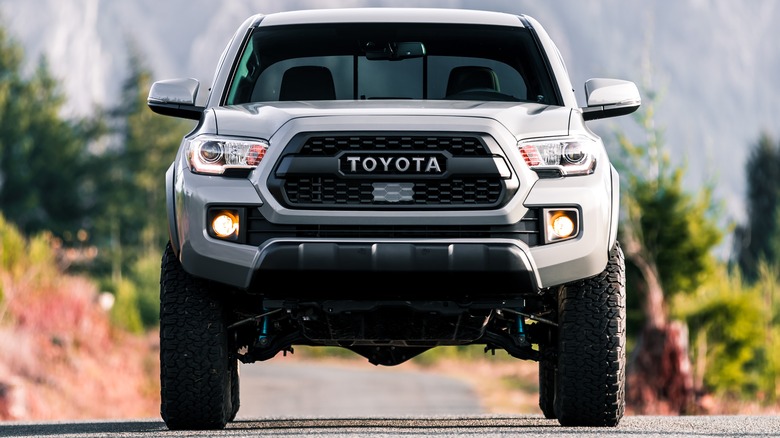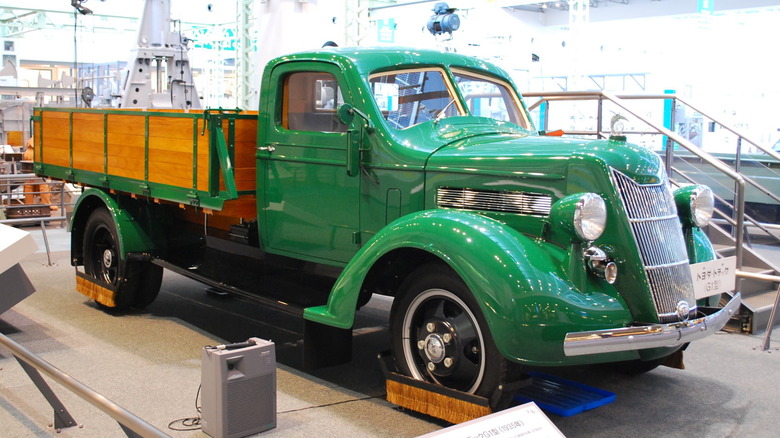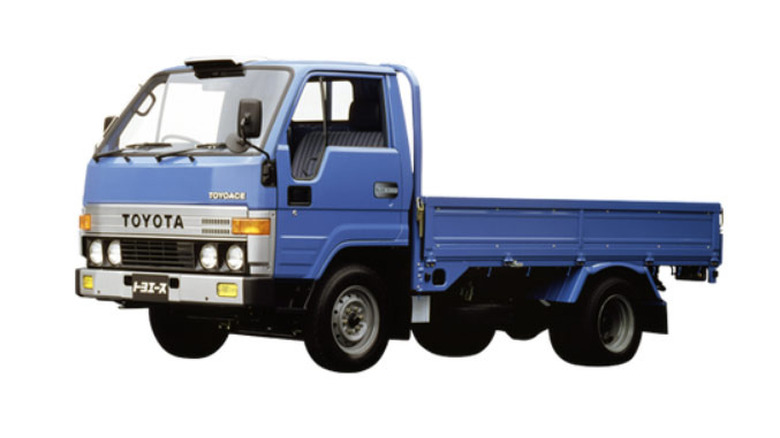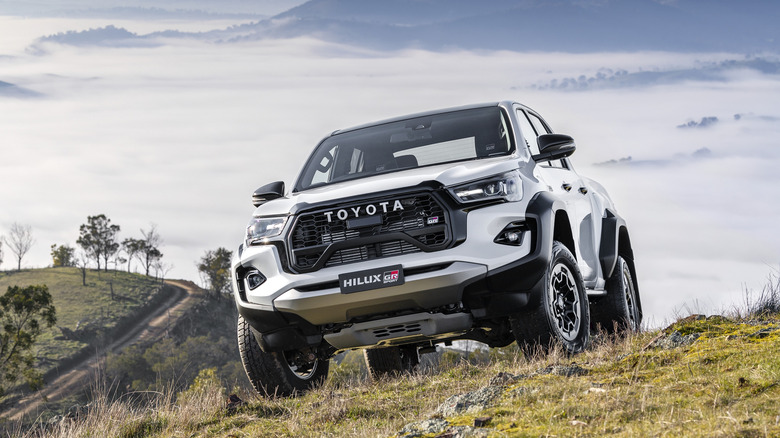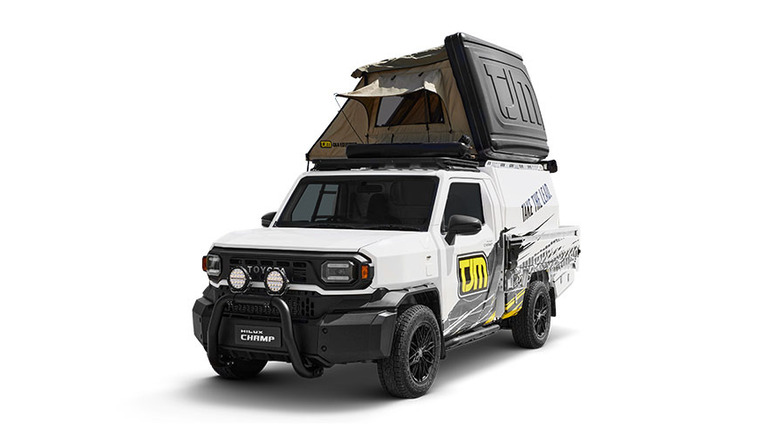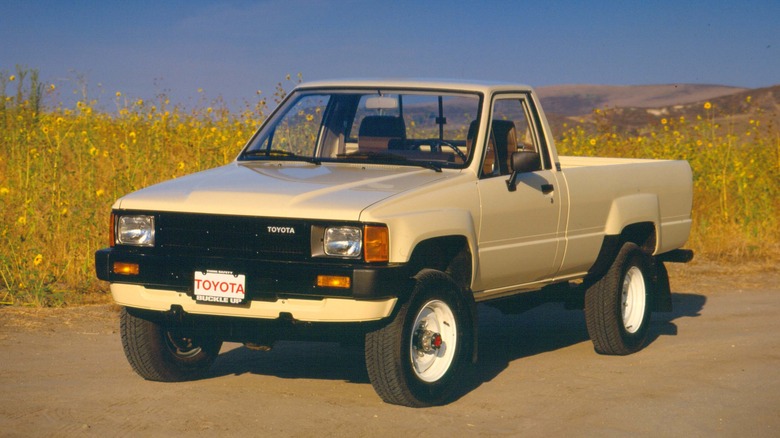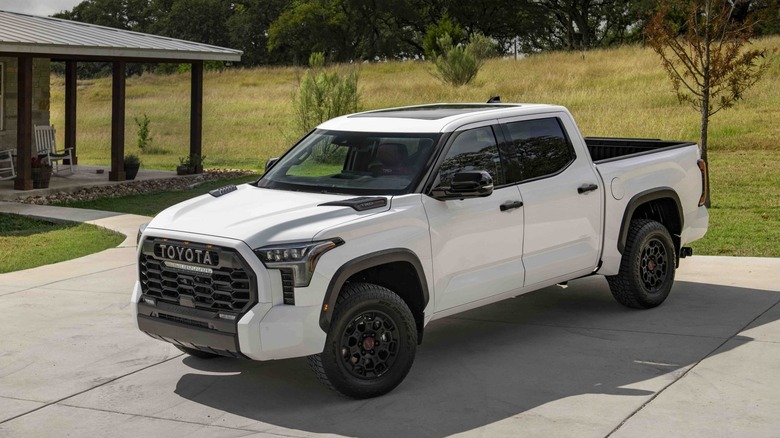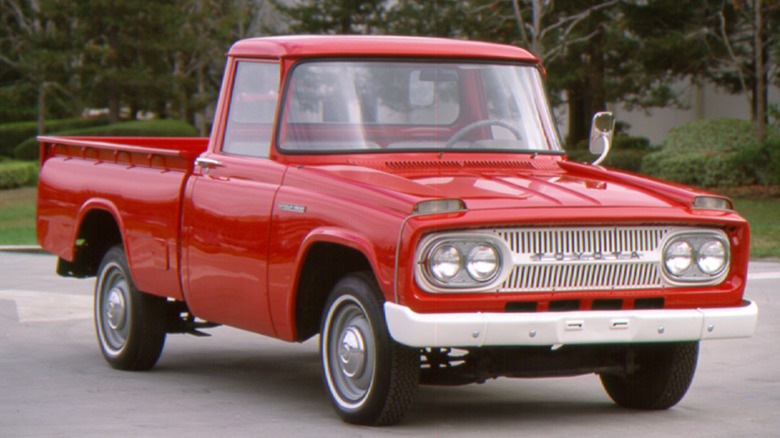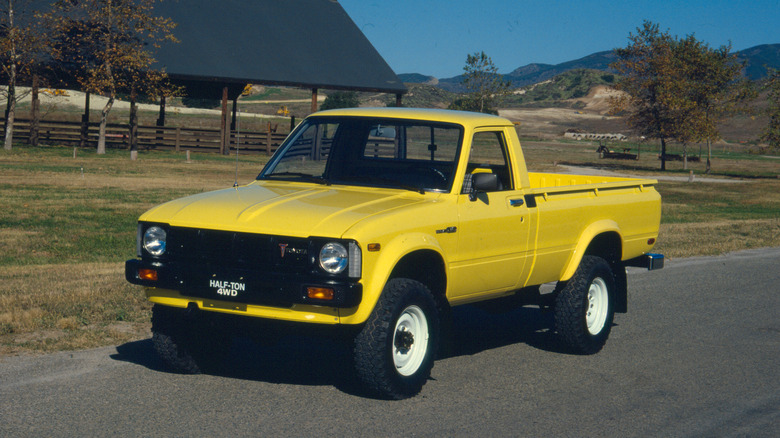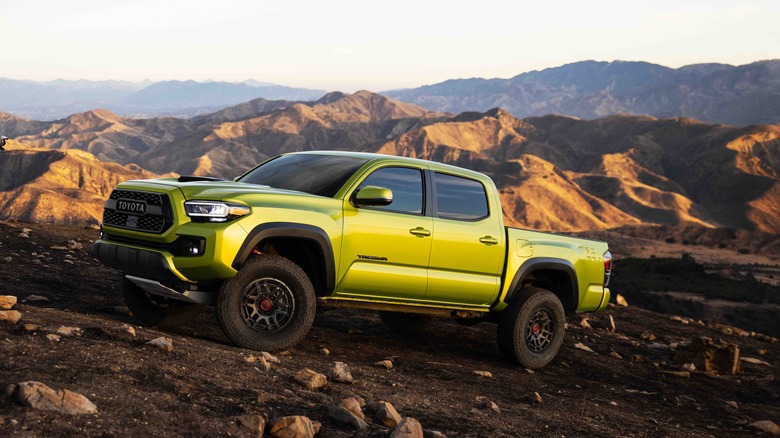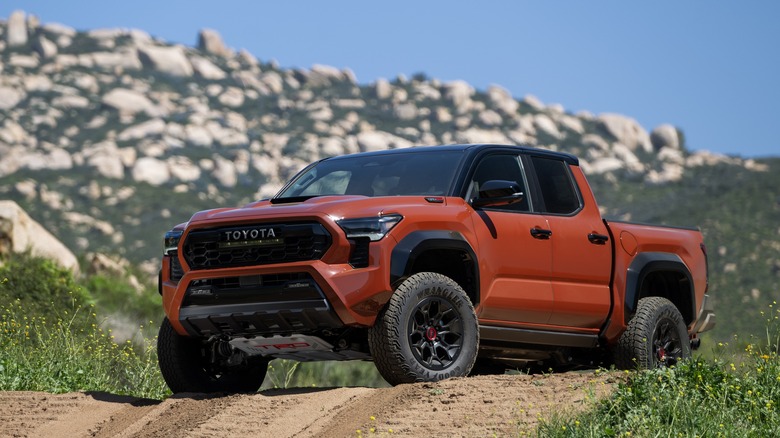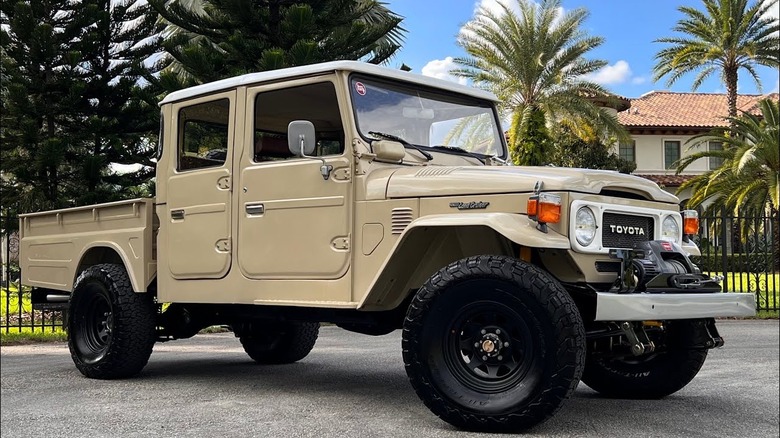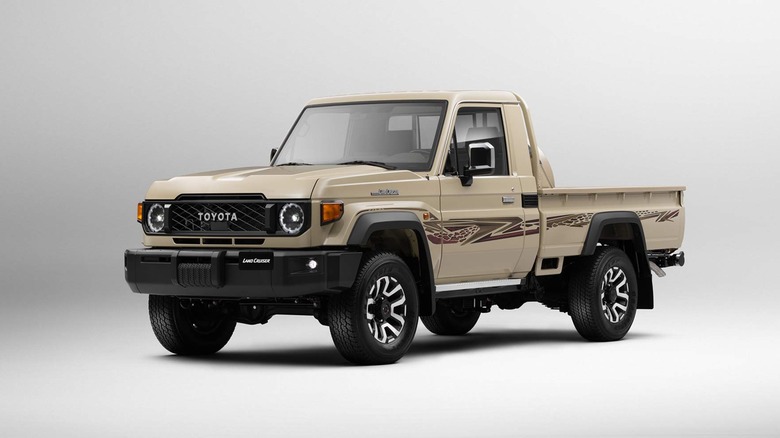12 Of The Best Looking Toyota Trucks Ever Designed
Toyota is the leading automaker in terms of sales and earnings. We often attribute its world-beating numbers to its lean production system, reliable vehicles, model diversity, and innovation. However, few credit its success to the design of its vehicles, as those have often been described as conservative and maybe even a little boring. Still, there are not enough fingers on our hands to count all of Toyota's successful designs in its almost 90-year history. Don't agree? Check the svelte Toyota 2000 GT, Japan's first supercar.
With that in mind, we are ready to up the ante here and give you 12 of the best-looking Toyota trucks ever designed. Yes, the Japanese automotive giant has also produced some attractive trucks in its history, starting from its production of commercial vehicles in the 1930s. In this article, we will celebrate all those cool-looking Toyota trucks, tell you why we like their design, and sprinkle up some nerdy details. The list is ascending, though each truck is good looking in its own right. So, buckle up because you'll see quite a few attractions in this Toyota truck theme park!
Toyota G1 (1935 to 1936)
Toyota's first-ever truck, the G1, was designed as a 20-foot transportation truck for carrying heavy loads. It was even developed by borrowing technology from its Western peers — Toyota famously purchased a 1934 Ford pickup truck to learn more about these vehicles and built a prototype engine based on a 1933 Chevrolet unit. The result was a blend of technologies, though, in Toyota's defense, it used the best parts of each automaker.
Still, the G1 was not a copycat of any particular truck. Toyoda Automatic Loom Works, which was the name of the company before it became Toyota, even put its own signature design on the G1. Although not as flashy looking as the brand's modern trucks, the G1 has a stylized front end with unique design elements. The huge grille, for instance, is recessed at the top to emphasize the diamond-shaped hood mascot, while the hood flows fluidly into the windshield area.
The G1 wasn't a particularly powerful truck, and it initially had a water-cooled 3.4-liter inline-six engine with a single overhead camshaft that produced a measly 65 hp. Considering the truck's curb weight of 2,936 pounds, it was probably fast enough for the era, and it could even haul 3,300 pounds of additional cargo in its bed.
Fifth-Gen Toyota Toyoace (1985 to 1994)
The Toyoace is a JDM-only pickup truck with a cab-over design, which is a different approach from trucks in other markets. This approach dramatically reduces the cabin's size, opening up more space for cargo and helping the driver navigate tighter urban areas more easily. As such, it is a good example of how Japanese automakers approach vehicle development in their own country, where space in cities is at a premium.
What we particularly like about the fifth-gen model is the sleek aesthetic that is a bit reminiscent of Sony's first-ever Walkman, the TPS-L2. The straight, minimalist lines that form the rectangular body give off a utilitarian vibe but with a fresh, streamlined edge. Toyota's truck was even available in a similar color combo, with a blue body, silver grille surround, and orange turn signals. Heck, even the twin circular headlights give off a cassette player vibe! Toyota's designers might have never looked at the Walkman when designing the truck, but the resemblance is uncanny. Crucially, it is a cohesive design that works well even today.
Apart from its stylish appearance, the fifth-gen Toyoace was also a very capable pickup truck, designed to carry up to 7,700 pounds in it's most powerful configuration. However, it was only designed to be a functional truck, not a fun one, although the engine options included a 3.4-liter turbodiesel and a 4.0-liter regular diesel.
Toyota Hilux GR Sport II (2024 to Present)
The latest Hilux is one of the most popular pickup truck outside of North America, though the latest model isn't a particularly attractive vehicle. Toyota installed some modern design elements in the front end, but it still looks a little plain, especially when compared to its rivals. However, the same can't be said for the GR Sport version, which has a different front fascia that makes it much more interesting to the eyes.
Notably, the GR Sport got rid of the weird plastic grille surround, giving it a cleaner look overall. Instead of the black plastic, Toyota's designers opted for a larger black grille, which gives the truck a much meaner, sportier look. The sporty look is further emphasized by the prominent Dakar-inspired skid plate below, wide black wheel arches, and heavy-duty rock rails on the sides. The Hilux GR Sport even looks different at the rear, with a thicker bumper that incorporates rear recovery points.
The GR Sport isn't all show, though. The Gazoo Racing engineering team gave the 2.8-liter turbodiesel engine 10% more power (221 hp) while also employing a more advanced off-road suspension featuring KYB monotube shocks with better heat dissipation, stiffer coils, and higher dampening force. As a result, you can push the Hilux GR Sport harder on challenging trails, much like this model does when participating in Gazoo Racing's Hilux-based Dakar racer. That said, we would've probably preferred a more powerful gas engine like the 2.4-liter turbo from the Tacoma, which produces 278 hp.
Toyota Hilux Champ (2023 to Present)
There is a general consensus today that trucks need to look muscular and aggressive to be attractive. This led the industry to employ ever larger grilles – even Toyota is guilty of over-designing the front end in the latest Tundra. However, the Japanese automaker produces a smaller pickup truck specifically for the Asian market, whose design aesthetic is the opposite of aggressive. Instead, the Hilux Champ looks funky and chic without losing its utilitarian edge.
You might be scoffing at the use of black plastics, but they contrast the rest of the truck nicely. Besides, Toyota opted for plastic for a reason – the Hilux Champ starts at only $13,000. So, it's not only adorable but affordable too. For that money, you only get a 70%-finished barebones truck, but that opens up a sea of possibilities for further customization. For instance, you can put a bed and drive it as a regular truck, make it into a full-fledged camper, an emergency vehicle, or anything else, really.
As part of the IMV (International Multi-purpose Vehicle) initiative, the Hilux Champ is designed to give businesses in developing economies a more affordable entry into mobility. It should be reliable, too, as it borrows the engines from the Hilux.
Toyota Pickup/Hilux Fourth-Gen (1984 to 1988)
The DeLorean time machine vehicle is as popular as the "Back to the Future" movie itself, which is not surprising given it flew Marty McFly and Dr. Emmett Brown through time. However, another prominent vehicle in the movie was the fourth-gen Toyota Pickup SR5, which was also sold under the Hilux brand in other markets. Completely black, with some off-road add-ons, like all-terrain tires and additional lights, the truck looked cool in its own right.
Of course, it pales in comparison to the DeLorean DMC-12, but as far as 1980s trucks go, it's a looker. What makes it attractive is its simplicity — it almost seems like the designers used rulers for the sketches. And we mean that in a good way because the proportions are just right. Moreover, the use of rectangles, like for the wheel arches, grille, headlights, and turning lights, gives the fourth-gen Pickup SR5 cohesiveness in the appearance that's hard to find in modern pickup trucks. Heck, even the instrument panel has a grid-patterned math notebook style!
Like most pickup trucks of the 1980s, Toyota's entry wasn't particularly fast. Initially, it was available with a 2.4-liter naturally-aspirated four-cylinder producing 116 hp, though Toyota later put a turbocharger on the engine and boosted it to 135 hp. For the last model year, the Pickup received a 3.0-liter V6 producing 145 hp. Crucially, all these engines and the model itself proved supremely durable, as shown in the infamous Killing a Toyota segments from "Top Gear."
Toyota Tundra TRD Pro (2021 to Present)
The latest Tundra is unlike any pickup truck Toyota has produced to date. Unlike most of the brand's past offerings, this full-size monster is the opposite of minimalistic. It's an aggressive, brash take on the style, with a front grille that could swallow the second-gen Toyota Pickup and still have space for dessert.
You could argue that Toyota went too far with the styling, but you can't deny its road presence. For this list, we've chosen the Tundra TRD Pro, which pushes the massive design elements to unseen heights. The sporty model features a black grille, which looks more sedate than the chrome one but incorporates the classic Toyota logotype underlined by a powerful LED off-road light. The scoops on the massive hood, huge all-terrain tires, lifted suspension, and black wheel arches further accentuate the bold look of the Tundra TRD Pro, making it a sight to behold.
The best part — it's not all bark, no bite. The Tundra TRD Pro is equipped with a potent i-FORCE MAX 3.5-liter twin-turbo hybrid, producing 437 hp and a massive 583 lb-ft of torque. Thus, as we've found in our review, the Tundra TRD Pro feels surprisingly sporty while offering good tow and haul ratings. You should really have an established need the added off-road capability if you are opting for the TRD Pro over other trims, though, as the suspension is bouncy and adds around a foot to the turning diameter.
Toyota Stout (1965 to 1966)
The Stout was Toyota's first full-fledged pickup truck entry in North America, signaling the things to come from the Japanese automaker. It wasn't a sales success, perhaps because the North American market wasn't ready for a Japanese pickup truck. It was certainly not because of its design, as the Stout looked quite modern when launched.
There are a few design elements that gave the Stout a fresh look compared to its rivals. Notably, the flat-top hood was a trendy feature at the time, and Toyota incorporated it into the Stout before any of its passenger vehicles. The hood was accentuated by two bumps on each end, which led the way to the turning lights. Meanwhile, the white grille and twin circular headlights with oval surrounds gave the truck a unique character, while the wrap-around windshield made it sleeker. Even the surfacing of the side panels was immaculate and connected the front and rear design perfectly.
In North America, the Stout was available with a 1.9-liter four-cylinder engine producing 86 hp. The small truck was also only available with a 4x2 powertrain, which might have been another reason why it didn't sell well. Despite that, the thought of a small and inexpensive pickup truck with Toyota reliability entices customers to this day, which is why rumblings about a Stout successor are becoming louder lately.
Toyota Pickup/Hilux Third-Gen (1979 to 1981)
The third-gen Toyota Pickup for North America, which gained steam in other markets as the Hilux, was the first in the series with an advanced off-road drivetrain. It had selectable 4WD with low-range gearing, allowing it to cross over almost any obstacle. However, the crucial part was the massive 12-inch ground clearance, which not only helped with off-roading but manifested the truck's rugged credentials.
This truck doesn't hide its massive differentials or solid axles — it shows them off. It gives the casual observer an idea of what it's capable of without using a flashy grille or massive wheel arches. Everything else about the third-gen Pickup/Hilux is simple, though with enough flair to capture the eyes. For instance, the hood tapered down to connect with the grille, giving the truck a keener look, and in some trims, Toyota used liveries to brighten up the design. As a result, the third-gen Pickup looks cool without being too flashy.
Depending on the market, the third-gen Pickup/Hilux was available with 1.6-liter, 2.0-liter, 2.2-liter, and 2.4-liter engines. The largest one, codenamed 22R, is the most potent and famous for being one of the most reliable engines in automotive history. Don't mistake "most potent" for fast, though, as the most powerful version of the 22R made only 105 hp.
Toyota Tacoma TRD Pro Third-Gen Facelift (2021 to 2022)
The third-gen Tacoma was initially behind the times in a few key aspects compared to its rivals. It had no turbos, which left it just the underpowered 2.7-liter inline-four and 3.5-liter V6 engines on offer, and its six-speed automatic transmission was aging. However, strong sales for the third-gen Tacoma has shown that truck buyers don't care about 0-60 mph times and put a bigger emphasis on reliability and longevity. So, despite feeling a bit long in the tooth mechanically, the third-gen Tacoma remained the best-selling mid-size truck in the U.S.
The fact that it looked the part undoubtedly helped the Taco — as it is affectionally called by enthusiasts — to reach so many customers. Toyota did a great job with its styling, particularly the front end, which still looks modern and attractive. Still, the most handsome of them all is the facelifted TRD Pro model. With its prominent, but not oversized, black grille, Toyota lettering, sporty C-shaped headlights, TRD skid plate, and a sculptured bonnet with a huge scoop, the third-gen Tacoma TRD Pro looks ready to take on the Dakar Rally.
The 1.5-inch front and 0.5-inch rear suspension lift put an even stronger accent on the truck's off-road abilities, emphasized by the prominent black wheel arches. It also makes the Tacoma a far more capable off-roader with a 36.4-degree approach angle, 24.7-degree departure angle, and 26.6-degree breakover angle. The capable Fox internal bypass shocks are the icing on the cake of one of the most capable off-road trucks.
Toyota Tacoma TRD Pro Fourth-Gen (2023 to Present)
Toyota did well with the third-gen Tacoma, but the Japanese automaker wasn't going to stand still for longer and allow its competitors to capture the limelight with higher technology offerings. So, the brand-new Tacoma, launched for the 2023 model year, brought an all-new 2.4-liter turbocharged inline-four engine producing 278 hp in the SR5 and TRD Off-Road models and 326 hp in the TRD Pro hybrid model. More importantly, the hybrid produces a mammoth 465 lb-ft of torque, making the truck quite eager off the line.
Despite making it a technology powerhouse, Toyota kept the design of the truck recognizable. Sure, every panel on the new model is different, but you won't mistake it for any other truck. That's not to say Toyota's designers were lazy, though. The fourth-gen truck has a much more muscular body with creases and angles on the body panels that give the truck a brawnier appearance. Even the bed is more stylized than before and connects seamlessly to the rest of the body.
Like before, the TRD Pro model is by far the best-looking of the bunch. The fact that there is no metallic finish anywhere on the truck exemplifies its sporty nature, with the black grille, skid plate, air intakes below the headlights, roof, wheel arches, and hood scoop creating quite a menacing appearance. Some might think the Tacoma TRD Pro is too intimidating, but in our eyes, it looks like an off-road truck from the future.
Toyota Land Cruiser FJ43/FJ45 Pickup (1963 to 1986)
The futuristic fourth-gen Tacoma is chic, but in our eyes, it pales to the retro charm of the Land Cruiser FJ43/FJ45 pickup. This vintage truck oozes coolness from every angle and remains one of the most popular classic off-roaders. FJ45 restomods with amped-up V8 engines are popular with enthusiasts too, confirming that people are into the design of this pickup truck enough to invest some serious money into it.
What sets the FJ45 Land Cruiser apart is the instantly recognizable front end. To differentiate itself from Jeep and Land Rover, Toyota used a white bezel to surround the headlights and grille, with the Toyota logotype sitting proudly in the middle. The bonnet is unique, too, featuring an air inlet that visually connects with the grille below. Most models had a white roof, too, which was an extension of the light-colored grille. The rest of the body is quite utilitarian, but isn't that what pickup trucks are all about? Also, the fact that the FJ45 proudly presents all its 4WD off-road bits makes it even more attractive –- it looks almost half-naked from below.
Of course, the FJ43/FJ45 Land Cruiser is legendary for more than just its looks. In fact, it's renowned for its extraordinary reliability and durability, courtesy of the heavy-duty ladder frame and tough Type F engines. The FJ45's off-road credentials are nothing to scoff at, thanks to its fully-equipped 4WD drivetrain with a low-range/high-range transfer case and excellent road clearance.
Toyota Land Cruiser 70 Pickup (2023 to Present)
What better way to complete this list than with Toyota's most classic and longest-lasting truck, the Land Cruiser 70 Series Pickup? Launched in 1984, this antique still attracts buyers in various markets around the world. It is a simple, minimalistic take on a pickup truck designed to get the job done for years to come. You certainly won't be getting the Land Cruiser 70 Pickup for speed, as the new 2.8-liter turbodiesel produces only 201 hp, but for hauling heavy cargo and traversing challenging trails, there is probably no better truck available.
The 70 Series is not fast, but you can't deny its style. In 2023, Toyota refreshed the aging SUV/truck with a revised front end featuring new LED headlights, a more sculpted bonnet with a similar air inlet to the FJ43/FJ45, and a simpler black grille. The design refresh didn't make the 70 Series more modern — quite the opposite. Before the facelift, the 70 Series was beginning to look somewhat forgettable due to Toyota's insistence on making more contemporary.
This new model, though, looks like a restomod of the original — in a good way. It's chunkier, thanks to the wider wheel arches and elevated bonnet, yet more minimalistic because it only has simple geometrical forms. These utilitarian looks suit the 70 Series Pickup really well, especially in beige. In some markets, Toyota even implements interesting liveries to brighten up the looks. The best part is that the Land Cruiser 70 Pickup will still look cool decades into the future, just like the FJ43/FJ45 today.
